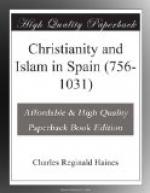[1] Dozy, ii. 108, puts the distinction between the races very forcibly:—“Ce peuple qui joignait a une gaite franche et vive une sensualite raffinee devait inspirer aux pretres, qui aimaient les retraites eternelles et profondes, les grands renoncements et les terribles expiations, une repugnance extreme et invincible.”
[2] Dozy, ii. 223.
[3] “C’etait leur terme consacree.” Dozy, ii. 211.
[4] “Heu pro dolor! quia esse sub Gentibus delicias computamus, iugumque cum infidelibus ducere non renitimur. Et inde ex cotidiano usu illorum sacrilegiis plerumque utimur et magis ipsorum contubernia affectamus.”—Eul., “Doc. Martyr,” sec. 18.
[5] Conde, i. 244: “Chron.
Alb.,” vi. sec. 58: “Chron. Lib.,”
sec. 30.
[6] Al Makkari, ii. 161, Ordono the Bad and Hakem II.
Again, as was inevitable from the nature of the case, intermarriages were common between the two races. The example was early set by the widow of Roderic, the last Gothic king, marrying Abdulaziz, son of Musa. The sons of Witiza also married Arab women, and Sarah, the daughter of one of these princes, was the progenetrix of a noble family of Arabs, one of her descendants being the historian, Ibn al Kuttiya, which means son of the Gothic princess.[1] Abdurrahman Anassir, the greatest of all the Spanish Sultans, was the son of a Christian slave, named Maria,[2] and the mighty Almanzor had for grandmother the daughter of a renegade Christian.[3] These are some instances, but it is not necessary to dwell on what was so common an occurrence as intermarriage between the peoples, and is forbidden neither by the Koran,[4] nor by the Bible.
However, there is one point in this connection which deserves a more particular notice. The intermingling of the races has been supposed to have been facilitated in part by the yearly tribute of 100 maidens paid by the northern kings to the earlier Arab Sultans. Modern historians mostly throw doubt upon the story, saying that of the early historians none mention it, and that the Arabs do not even allude to it.[5] But if Conde is to be trusted, an Arab writer does speak of it, as of a thing well known. In a letter of Omar[6] ibn Alaftas Almudafar, King of Algarve, to Alfonso VI., in 1086, occur the words:—“Do thou remember the time of Mohammed Almanzor, and bring to thy mind those treaties wherein thy forefathers offered him the homage even of their own daughters, and sent him those damsels in tribute even to the land of our rule.”
[1] Al Makkari, ii. 15, 22, and De Gayangos’ note, p. 454.
[2] Conde, i. 364.
[3] Dozy, iii. 124.
[4] Koran, v. 5:—“Ye
are allowed to marry free women of those
that have received the Scriptures
before you.”
[5] Dunham, ii. 131: Romey’s “Histoire d’Espagne,” iii. 276.
[6] Conde, ii. 238: Al
Makkari, ii. 256, calls him Omar ibn
Mohammed etc ibn Alafthas
Almutawakkel, King of Badajos.




